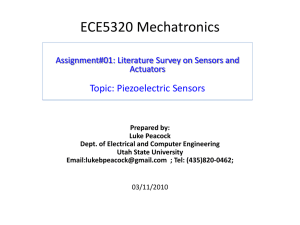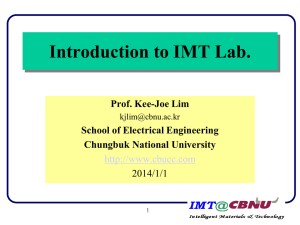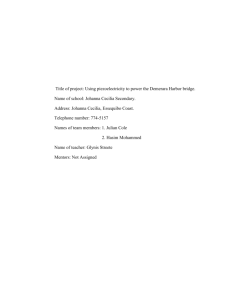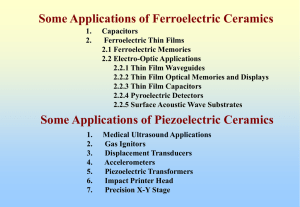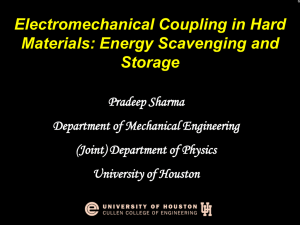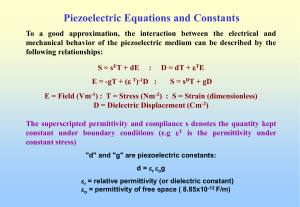Piezoelectric Materials - The American Ceramic Society
advertisement
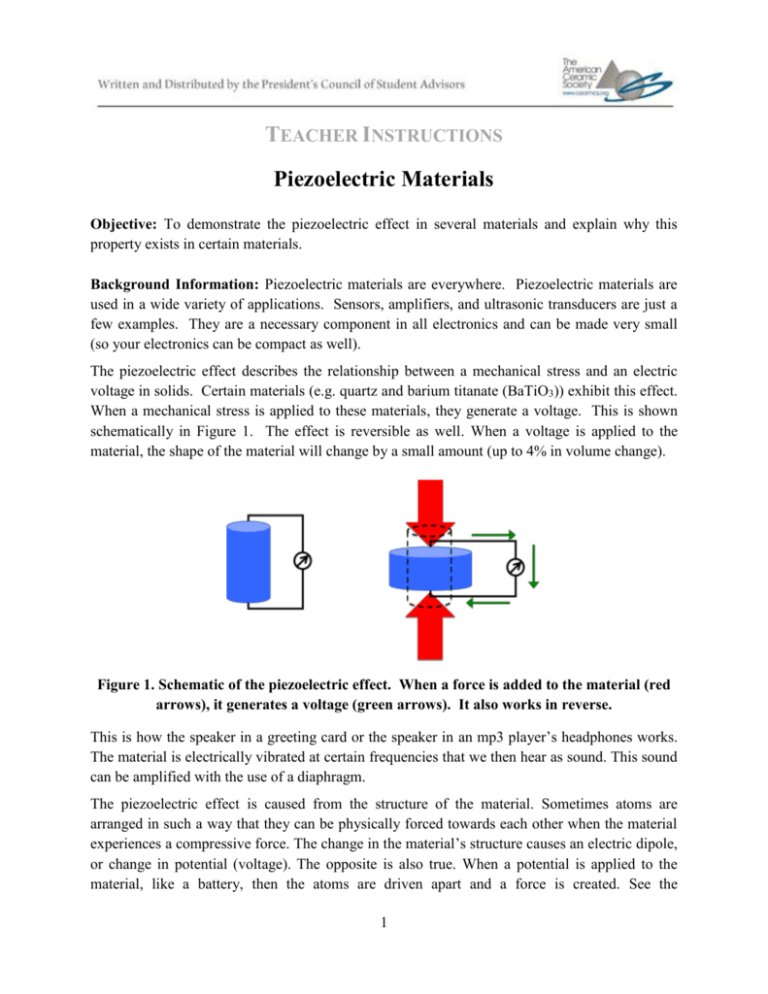
TEACHER INSTRUCTIONS Piezoelectric Materials Objective: To demonstrate the piezoelectric effect in several materials and explain why this property exists in certain materials. Background Information: Piezoelectric materials are everywhere. Piezoelectric materials are used in a wide variety of applications. Sensors, amplifiers, and ultrasonic transducers are just a few examples. They are a necessary component in all electronics and can be made very small (so your electronics can be compact as well). The piezoelectric effect describes the relationship between a mechanical stress and an electric voltage in solids. Certain materials (e.g. quartz and barium titanate (BaTiO3)) exhibit this effect. When a mechanical stress is applied to these materials, they generate a voltage. This is shown schematically in Figure 1. The effect is reversible as well. When a voltage is applied to the material, the shape of the material will change by a small amount (up to 4% in volume change). Figure 1. Schematic of the piezoelectric effect. When a force is added to the material (red arrows), it generates a voltage (green arrows). It also works in reverse. This is how the speaker in a greeting card or the speaker in an mp3 player’s headphones works. The material is electrically vibrated at certain frequencies that we then hear as sound. This sound can be amplified with the use of a diaphragm. The piezoelectric effect is caused from the structure of the material. Sometimes atoms are arranged in such a way that they can be physically forced towards each other when the material experiences a compressive force. The change in the material’s structure causes an electric dipole, or change in potential (voltage). The opposite is also true. When a potential is applied to the material, like a battery, then the atoms are driven apart and a force is created. See the 1 Introductory Presentation for examples of how the piezoelectric effect is used in real-world applications. Demo Description: In this demo, the piezoelectric effect of a ceramic disk and a polymer film will be demonstrated through the use of LEDs. Two of each piezoelectric material have been included in the kit so that you may keep one to demonstrate and pass one among the students. Keywords: Piezoelectric: effect of generating electric charge from applied force Ceramic: classification of materials which are inorganic, non-metal solids Polymer: classification of materials which are characterized by long, chain-like molecules that typically have repeating sub-units Structure: arrangement of atoms within a material Potential: difference in electric charges resulting in the capacity to do work Force: influence exerted on an object, such as pressure or tension Materials List: Items provided in the kit: 2 Piezoelectric ceramic disks 2 Piezoelectric polymer films 4 LEDs 8 Alligator clip sets Items to be provided by the teacher/school: 9 Volt battery Musical greeting card Headphones Voltmeter Safety Precautions: Too much force on either piezoelectric material can permanently damage them. Instructions: 1. Test both piezoelectric materials prior to starting the demonstration to make sure neither is damaged or needs to be replaced. 2. Connect 1 LED to each piezoelectric material so that the long wire of the LED is connected to the red wire coming from the piezoelectric material, and the short wire on the LED is connected to the black wire of the piezoelectric material. Use the supplied alligator clips to make these connections (Figure 2). 2 Figure 2. LED and piezoelectric polymer film connected by alligator clips 3. Place the ceramic disk on a flat surface and tap down on the white center (Figure 3). Start with a very light tap and slowly increase the force until the LED visibly flashes with each tap. Show effect to students. Figure 3. Piezoelectric disk ready to be tested 4. Pass the other ceramic disk with LED among the students and let them try it at their own desk (you can also pass both ceramic disks if you are done demonstrating). Caution students not to use too much force as this will damage the disk. This is why it is best to start with a light tap and slowly increase the force until the LED visibly flashes. 5. Bend the polymer film back and forth slowly (Figure 4), increase the speed at which you are bending the material until the LED lights up with each bending motion. Show the effect to the students. 3 Figure 4. Bending the polymer film 6. Pass the polymer film(s) among the students and let them try it at their own desk. Caution students not to fold the film, but rather to bend it. Folding and creasing the film will damage it. 7. Open the musical greeting card and explain the use of piezoelectric materials as a speaker. Take apart the card so that students can see the actual piezoelectric ‘buzzer’. Supply students with the Background Information on piezoelectric materials. A reproduction of Figure 1 should be created as a demonstration aid, linking it to the ceramic disk and polymer films used. 8. Attach the two wires of the polymer film to a 9 volt battery and show the students the effect of the battery’s potential on the piezoelectric polymer film. OPTIONAL ADDITIONS TO THE DEMO 9. Use a voltmeter in place of the LED to measure the voltage generated by the piezoelectric. This provides a better indication of the piezoelectric effect as the light generated by the LED is very minimal. 10. Connect the two piezoelectric materials in series and try to generate more voltage by simultaneously activating both materials. 11. Create a simple circuit by connecting the ceramic disk directly to the polymer film. Attempt to make the polymer film bend by striking the ceramic disk. Demo Delivery Hints: Interest is key. This demonstration can be boring if you are not interested in it yourself. Try to be excited about the piezoelectric affect. The video “How a quartz watch works” can be used as an introduction: http://www.youtube.com/watch?feature=player_embedded&v=1pM6uD8nePo 4 Troubleshooting: If either piezoelectric material is damaged or not working, then replacements should be purchased. If the demonstration isn’t functioning, then the piezoelectric materials are most likely the cause (the LEDs are nearly indestructible). Clean-up/Replacement parts: Disconnect the LEDs from the piezoelectric materials and return all materials to the kit. LEDs can be found at any electronics store for very little cost if they are lost or stolen. Piezoelectric ceramic disks can be purchased from online electric suppliers, including eBay. They are typically referred to as “transducers”. It is recommended to purchase the disks with wires already attached (for ease of use). Piezoelectric polymer films can also be purchased from online electronic suppliers. They are commonly referred to as “piezoelectric vibration sensors”. It is also recommended to purchase films with wires already attached (for ease of use). DISCLAIMER: ACerS’ President’s Council of Student Advisors (PCSA) provides these lesson documents in an editable Word format so that teachers may adapt the documents for their classroom needs. The PCSA encourages teachers to download and modify these documents as needed for their own classroom and to provide these documents to other teachers who are interested. As a result, you may not be reading an original version of the document. Original versions of the document may be downloaded from www.ceramics.org/pcsasciencekits . This disclaimer should be present in every version of the document that is shared among teachers. 5 TEACHER DISCUSSION QUESTIONS Piezoelectric Materials Discussion Questions to Ask Before the Demo 1. How do we as a society make electricity? Discussion: We typically use generators powered by water or steam pressure, wind, solar, coal, or nuclear power. 2. What objects or materials generate electricity? Discussion: Magnets (generator), batteries (chemical reaction) Discussion Questions to Ask During the Demo 1. Why does the LED have to be polarized (red and black wires)? Discussion: The charge only moves in one direction when the material is compressed. 2. What do these piezoelectric materials have in common? Discussion: A similar structure that allows atoms to be forced together. 3. What is generating the charge observed as light from the LED? Discussion: The movement of atoms within the material causing an electric dipole to light the LED. Discussion Questions to Ask After the Demo 1. What are potential applications this material could be used for? Discussion: Sensors, speakers, actuators, buzzers, switches, and power generation. 2. Is human hair a piezoelectric material? Discussion: It is…ever statically charge a balloon by rubbing it on your head? DISCLAIMER: ACerS’ President’s Council of Student Advisors (PCSA) provides these lesson documents in an editable Word format so that teachers may adapt the documents for their classroom needs. The PCSA encourages teachers to download and modify these documents as needed for their own classroom and to provide these 6 documents to other teachers who are interested. As a result, you may not be reading an original version of the document. Original versions of the document may be downloaded from www.ceramics.org/pcsasciencekits . This disclaimer should be present in every version of the document that is shared among teachers. 7 STUDENT QUESTION HANDOUT Piezoelectric Materials 1. What is the piezoelectric effect? 2. What causes the piezoelectric effect? 3. Name a type of material that can have the piezoelectric effect. 4. Name one current use of this material property. 5. What is a potential application of this material? Where could you use the piezoelectric effect? 8 The American Ceramic Society Materials Science Kits Warranty Disclaimer, Limitation of Liability and Safety Disclaimer NO WARRANTY – DISCLAIMER OF WARRANTY THE AMERICAN CERAMIC SOCIETY (ACerS), OFFERS THE MATERIALS SCIENCE KITS “AS-IS”, WITH NO WARRANTIES WHATSOEVER, EXPRESS OR IMPLIED, INCLUDING, WITHOUT LIMITATION, WARRANTIES OF MERCHANTABILITY, SAFETY, FITNESS FOR ANY PARTICULAR PURPOSE OR NON-INFRINGEMENT OF PATENTS, COPYRIGHTS OR OTHER PROPRIETARY RIGHTS OF OTHERS. SOME STATES AND JURISDICTIONS DO NOT ALLOW LIMITATIONS ON IMPLIED WARRANTIES, SO THE ABOVE LIMITATIONS MAY NOT APPLY TO CUSTOMER. WHEN THE IMPLIED WARRANTIES ARE NOT ALLOWED TO BE EXCLUDED IN THEIR ENTIRETY, THEY WILL BE LIMITED TO THE SHORTEST DURATION PERMITTED UNDER APPLICABLE LAW. CUSTOMER MAY ALSO HAVE OTHER RIGHTS WHICH VARY FROM STATE TO STATE. WITHOUT LIMITING THE GENERALITY OF THE FOREGOING, ACerS DOES NOT WARRANT THAT EACH MATERIALS SCIENCE KIT IS COMPLETELY ERROR FREE, WILL OPERATE WITHOUT INTERRUPTION, OR IS COMPATIBLE WITH ALL EQUIPMENT AND SOFTWARE CONFIGURATIONS. CUSTOMER EXPRESSLY ASSUMES ALL RISK FOR USE OF THE MATERIALS SCIENCE KITS. LIMITATION OF LIABILITY TO THE MAXIMUM EXTENT PERMITTED BY LAW, ACerS WILL NOT HAVE ANY LIABILITY OR RESPONSIBILITY TO CUSTOMER FOR DAMAGES OF ANY KIND, INCLUDING SPECIAL, INDIRECT OR CONSEQUENTIAL DAMAGES (INCLUDING, WITHOUT LIMITATION, DAMAGES FOR LOSS OF DATA), ARISING OUT OF OR RESULTING FROM THE MATERIALS SCIENCE KITS, ANY COMPONENT, DOCUMENTATION, SERVICES OR MATERIALS MADE AVAILABLE TO CUSTOMER IN CONNECTION WITH THE MATERIALS SCIENCE KITS OR THE USE OR MODIFICATION OF ANY OF THEM, EVEN IF ACerS HAS BEEN ADVISED OF THE POSSIBILITY OF THE DAMAGES. IN ANY CASE, ACerS’S AND ITS LICENSORS’ ENTIRE LIABILITY UNDER ANY PROVISION OF THIS AGREEMENT WILL BE LIMITED TO THE AMOUNT ACTUALLY PAID BY CUSTOMER TO ACerS FOR THE PRODUCT OR TEN DOLLARS ($10.00), WHICHEVER IS GREATER. Some states do not allow the limitation or exclusion of liability for incidental or consequential damages, or have legislation which restricts the limitation or exclusion of liability, so the above limitation may not apply to Customer. CALIFORNIA RESIDENTS California Residents: I understand that I am waiving rights with respect to claims that are at this time unknown or unsuspected, and in accordance with such waiver, I acknowledge that I have read and understand, and I hereby expressly waive, the benefits of section 1542 of the civil code of California, and any similar law of any state, country or territory, which provides as follows: “A general release does not extend to claims which the creditor does not know or suspect to exist in his or her favor at the time of executing the release, which if known by him or her must have materially affected his or her settlement with the debtor.” MATERIALS SCIENCE SAFETY DISCLAIMER The materials science kits contain lessons that are believed to be reliable regarding the safe use and handling of these materials in laboratories and student classrooms. ACerS, however, does not represent or warrant in this, or in any other publication, to specify minimum safety or legal standards or to address all of the compliance requirements, risks, or safety problems associated with the handling of hazardous materials, their use, or the methods prescribed for using them in laboratories or classrooms. This information is intended to serve only as a beginning point for information and should not be construed as containing all the necessary compliance, safety, or warning information, nor should it be construed as representing the policy of ACerS. The kits should be used by minors (under 18) only with adult supervision. Without limiting the generality of the foregoing disclaimers, no warranty, guarantee, or other form of representation is made by ACerS as to the accuracy or sufficiency of the information and guidelines included with the materials science kits, and ACerS assumes no liability or responsibility concerning the use of such instructions and guidelines for any purpose. It is the responsibility of the users of these materials to consult and comply with pertinent local, state, and federal laws, regulations, and standards with respect to the handling of materials. Users of the materials science kits should consult with the school’s legal counsel or other professional advisers about the applicable laws, safety issues, and compliance issues for the storage of materials and the methods for using the materials in school classrooms and laboratories. THIS DISCLAIMER APPLIES TO ANY LIABILITY THAT IS, OR MAY BE INCURRED BY, OR ON BEHALF OF THE INSTITUTIONS THAT USE THE MATERIALS SCIENCE KITS; INCLUIDNG, WITHOUT LIMITATION, THE FACULTIES, STUDENTS, OR PROSPECTIVE STUDENTS OF THOSE INSTITUTIONS; AND ANY MEMBER OF THE PUBLIC AT LARGE; AND INCLUDES, BUT IS NOT LIMITED TO, A FULL DISCLAIMER OF ANY LIABILITY THAT MAY BE INCURRED WITH RESPECT TO POSSIBLE INADEQUATE SAFETY PROCEDURES TAKEN BY ANY USER. 9



